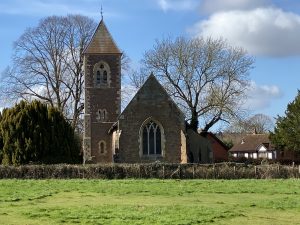Modern history
Bobbington, meaning the tun of Bubba’s people, was probably the site of the present village where there was a church by the 13th-century, and the area lay in the Kinver forest.
A school was established at White Cross, north east of the village, in 1792 by Hannah and Mary Corbett of Blakelands for 20 boys and 12 girls between the ages of 8 and 15, they were to be chosen from amongst the poorest in the parish.
In 1896 the school, known as the Free School of Hannah and Mary Corbett, or White Cross School, became a public elementary school with the endowment income benefiting the pupils.
In 1941 the Air Ministry opened an airfield at Halfpenny Green for use as a training station and buildings near the edge of the airfield were demolished, notably the timber-framed Gospel Ash Farm at the southern end and then the school buildings at White Cross. The new Corbett school was eventually built next to the Village Hall.
The parish contains several houses of historical interest including Bobbington Hall, Blakelands, Bobbington House, and Leaton Hall.
Early history

“Bobbington Parish, on the western verge of the county, nine miles SW of Wolverhampton, has a 418 souls and about 500 acres, with part of the hamlet of Halfpenny Green, are in Shropshire. The Earl of Stamford and William Moseley, Esq, are the principal proprietors of the soil, and the latter, who has a pleasant seat here, called Leaton Hall, is lord of the manor and impropriator, having purchased the tithes of the late Thomas Whitmore, Esq, of Apley. The Right Hon Sir L Shadwell, the Rev John Pratt, Mr Thomas Bowen, and a few smaller owners have estates in the parish.”
[From History, Gazetteer and Directory of Staffordshire, William White, Sheffield, 1851]